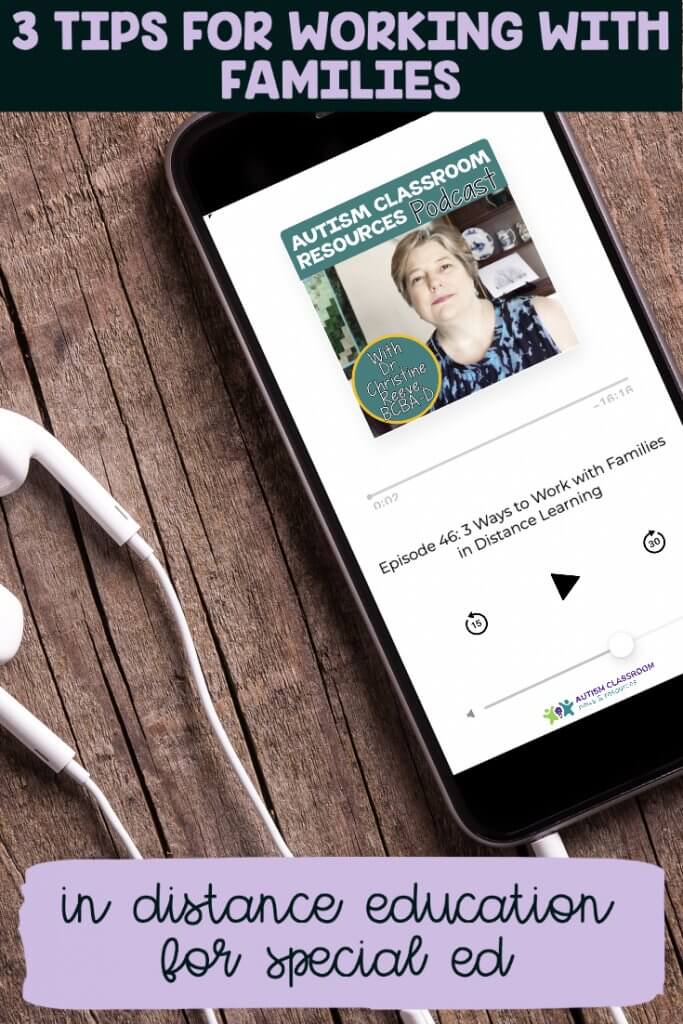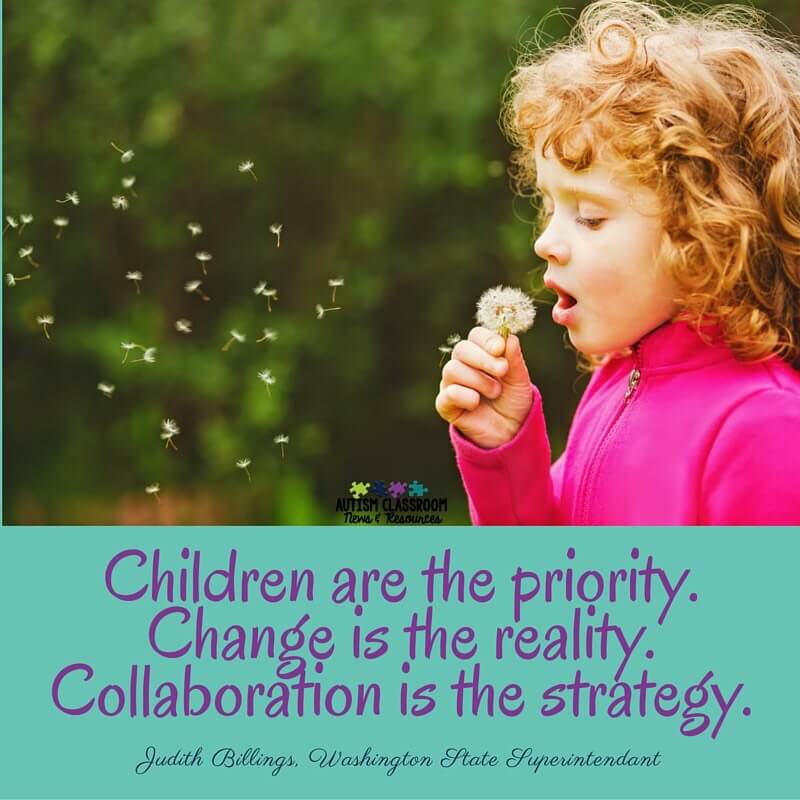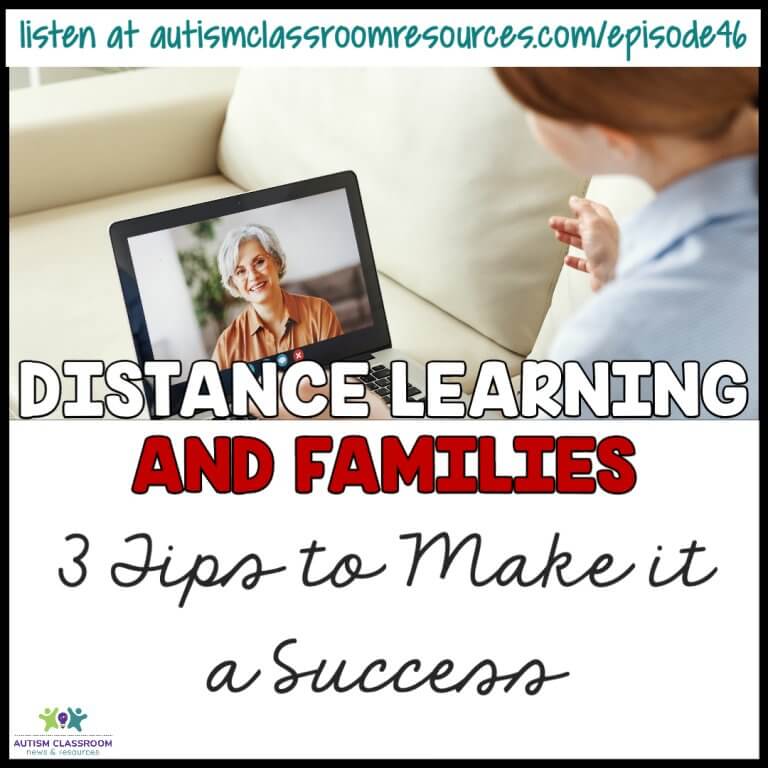In this episode, I share 3 strategies for working with families in distance learning for special education. I think we can all agree that the spring of 2020 when we started distance learning in special education in public schools was rough for families and teachers. Both rose valiantly to the situation, but everyone was pretty much building the plane as we flew.
Fast forward to Fall 2020 and many schools are facing that same choice. Whether we like it or not, distance learning is a fact of life for many families and teachers at the beginning of this school year. Given that distance learning for special education is here to stay at least temporarily, it’s important that we put arguing aside and figure out how to make it work. Because I know we can do better with it.
How Do We Do Distance Learning for Special Education Better?
This is the question we need to be asking. And I can’t answer it completely in a podcast. But, I do know that in order for distance learning for special education to be better, educators and families are going to need to work together. We need to build our relationships with each other. We need to communicate effectively. And we must build in accountability if we expect special education students to make progress.
So in this episode I want to focus on how we start to do all of that. I’ve got 3 tips that can help special education teachers to make distance learning a more positive and effective experience by working with families.
3 Tips for Working with Families in Distance Learning for Special Education
1. Start Small and Easy
It’s going to be really tempting after ending the year as we did to jump into the new year feet first. I know there will be pressure from school districts to test for retention. And teachers are eager to get started on everything they know their students need to learn.
But my first tip for teachers and for families is to resist this pressure. We need to start small. I mean this in a couple of different ways. And, it will actually help get a better assessment of the student’s skills.
Start With Mastered Tasks and High Reinforcement
First, we want distance learning to be successful for both families and students. Many families struggled in the spring to get their children to work effectively with them. Some of them saw more challenging behavior than we see at school. Others just had difficulty motivating their children to work for them as they do for the teachers. This isn’t unusual and doesn’t mean that the parents were doing anything wrong. Instead, it means that we have to work on getting “instructional control” between the parent and the child…just like we do in the classroom.
And the way that we do that is that we have teachers and paraprofessionals (and all educators) pair themselves with reinforcement. Starting with easier tasks means there is more opportunity for families to reinforce correct responses. That helps to make the instruction with them more reinforcing. Students need to experience that high level of reinforcement from their caregiver during instruction for the caregiver to work effectively with them.
Quick Wins for Parents in Distance Learning for Special Education
By starting with easier tasks, parents get quick wins (and thus reinforced) in working with their child. Yep, parents (and teachers) need reinforcement too!! We get reinforced, traditionally, by student success. Students’ challenging behavior in response to instruction, however, actually serves to punish our efforts. And over time, you may see willingness to work with students decrease. That, of course, is the opposite of what we want.
Assessing Retention Effectively
Finally, for this tip, let me address the elephant in the room. Yes we need to figure out what skills the students have retained in order to determine if there is a need for compensatory education. However, if our students were back in school, we would likely spend a week or two getting them adjusted to the routine. We spent the first week or so of school teaching the schedule, the rules, etc. It shouldn’t be different in distance learning.
Plus, if we jump right into testing, we will probably not get a good picture of what the student can and can’t do because there will be resistance. And families will still be struggling with making it all work. By spending some time starting out easy, students will perform better when the assessments start.
2. Collaborate With and Train Families
I keep hearing on television people talking about parents having to be their child’s teacher in distance education. In reality, though, that shouldn’t be completely accurate. And they certainly shouldn’t be doing it alone. Educators have the knowledge about how to teach, implementing curricula and more. Families have expertise in knowing their child and what he or she needs.
Parents or caregivers should be facilitators of the child’s education in distance learning. This role is difficult enough with all the other commitments they have going on. They shouldn’t be expected to teach the curriculum. For some students with significant disabilities, they will play a larger role in instruction. However, it is our responsibility, as educators, to teach the parents how to facilitate learning. It’s the educator’s responsibility to create the lessons and to collaborate with the family in how to implement those lessons.
Facilitators Need Training
Parents will need training. I just created a workshop on how to train families in the Special Educator Academy in addition to all our other resources on working with families. I created it specifically because this is a new role for teachers. And it will get even more attention as we move through this process. It will be a different type of relationship between schools and families. But it is a critical one in this instance.
Collaborate and Coordinate Learning
Part of this process of training and collaboration needs to include helping families figure out how to fit distance learning into their routines. I talked in Episode 35 about helping to fit learning into natural routines at home. I outlined some ways to do it and you can find more in this post about the Teaching at Home Toolkit.
Do a survey and connect with the families of your students. Ask questions about their routines and what times are good or not good for them to facilitate instruction. Help them work through how to manage all of this in conjunction with all the other commitments they have.
Introduce the Strategies Slowly
By starting small, you help parents start to build parts of the student’s learning into their everyday routine. Not all distance education needs to be face-to-face with the teacher. And it doesn’t need to take place only during school hours. If there is asynchronous practice that the student needs, they could do it at a time that works for the family.
For instance, if the student has an independent work system at home, and he is familiar with it from school, he could practice his skills while Mom is on a conference call or Dad is working with another child on schoolwork. Don’t limit yourself to thinking school is only during school hours.
3. Share Lesson Plans and Learning Plans
I mentioned earlier that it was important to differentiate that special educators bring expertise in education to the table. As educators we are responsible for planning the lessons, assuring that the IEP is met, making sure that strategies are working and evaluating progress. We need to document that.
But more importantly we need to collaborate and share that information with families. Families need written plans to work from. We should do the planning and collaborate with them in terms of scheduling. However, ultimately, the teacher needs to be responsible for monitoring how the plans are implemented.
Families Need Plans
Families need more than materials shared with them or online lessons. They need a cohesive plan for how this can be implemented in the home environment. Teachers need to know what goals can and can’t be implemented at home so they can address that within their district’s requirements for IEP changes. As teachers, we need to take the responsibility to lay out the lessons on a daily and/or weekly basis. Plans of course need to be flexible. Maybe a parent has more time to work with a student on one day than another.
Parents need to know how the IEP is being implemented and why they are working on specific activities. They need direction in how to break tasks down into smaller components. And they need plans for how to take a cooking lesson, for instance, and plan it out through a whole week.
Use the Teaching Implementation Plan
The TIP makes a great tool for laying out how instruction for the student from his/her IEP will be implemented across the curriculum and across the student’s day and week. It can serve as a distance learning plan of sorts if your district doesn’t already require one. It’s also a helpful tool for families to see the importance of activities they are asked to do and how they contribute to the child’s education.
So those are just some ways that educators and families can make the distance learning for special education work for them. I’ll leave you with this quote that I’ve always loved. I think it sums up specifically what we are being tasked to do in this extraordinary situation.
If you are looking for more ideas and strategies for making distance or classroom education work, the Special Educator Academy has what you need. We’ve got courses on distance learning, setting up your classroom and how to master difficult problems like data collection and behavior. Check it out below to grab your free trial.











